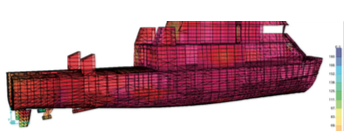Viga buque: Análisis de vibraciones forzadas por excitaciones de la hélice
DOI:
https://doi.org/10.25043/19098642.127Palabras clave:
vibración lateral, modelo de elementos finitos, modos de vibración de viga buqueResumen
La estela no uniforme alrededor de la hélice genera fuerzas fluctuantes en el eje de propulsión. Este artículo presenta una metodología usada para el análisis forzado de vibración de la viga buque debida a esta excitación de la hélice. Este procedimiento es aplicado a una lancha de investigación usando el método de elementos finitos incluyendo todas las estructuras de la nave, timón y líneas de propulsión con sus respectivos apoyos, considerando la hélice en el rango de operación. La masa añadida y amortiguamiento de todos los elementos sumergidos también se consideran en el análisis. Los niveles de vibración obtenidos en la estructura de la embarcación se comparan con los límites propuestos por ISO 6954 (2000).
Descargas
Referencias bibliográficas
AMERICAN BUREAU OF SHIPPING, Guidance on ship vibration, Houston, ABS, 2006.
DEPT. OF NAVAL ARCHITECTURE AND MARINE ENGINEERING OF UNIVERSTIY OF MICHIGAN, Propeller added mas and damping program (PRAMAD). Revision of September 5, 1980.
H. MUKUNDAN, Finite Element Analysis of a Rudder, Undergraduate Thesis for the completion of Bachelor of Technology in Ocean Engineering and Naval Architecture, Indian Institute of Technology, Madras, July 2002.
HOLDEN, FAGERJORD, FROSTAD, Early Design stage approach to reducing hull surface force due to propeller cavitation, SNAME Trans., 1980.
ISO, International Standard ISO 694: Mechanical vibration – Guidelines for the measurement, reporting and evaluation of vibration with regard to habitability on passenger and merchant ships, 2000.
IWER ASMUSSEN, WOLFGANG MENZEL, HOLGER MUMM, Ship vibration, Hamburg, Germanischer Lloyd, 2001
LEWIS F.M., The inertia of the Water Surrounding a Vibrating Ship, SNAME transactions, 1929.
M. PARSONS, Added mass and damping of vibrating propellers, Department of naval architecture and naval engineering University of Michigan, 1980.
RAMESWAR BHATTACHARYYA, Dynamics of marine vehicles, John Wiley & Sons, Inc., 1978.
S. QUEK, G.R. LIU, Finite Element Method: A Practical Course, Burlington MA, Elseiver Science, 2003.
SCHWANECKE H., Gedanken zur Frage der hydrodynamisch erregten Schwingungen des Propellers und der Wellenleitung, Jahrbuch STG, 1963.
T KUMAI, Some Aspects to the Propeller – Bearing Forces Exciting Hull Vibration of a Single Screw Ship, Research Inst. for Applied Mechanics, Kyushu Univ, 1961.
THOMSON W., Theory of vibration, New Jersey, Prentice Hall, 1972.

Descargas
Publicado
Cómo citar
Número
Sección
Licencia
The authors who publish in this Journal certify that:
- The work submitted for publication in The Ship Science and Technology journal, was written by the author, given that its content is the product of his/her direct intellectual contribution.
- All data and references to material already published are duly identified with their respective credits and are included in the bibliographic notes and quotations highlighted as such.
- All materials submitted for publication are completely free of copyrights; consequently, the author accepts responsibility for any lawsuit or claim related with Intellectual Property Rights thereof, Exonerating of responsibility to The Science and Technology for the Development of Naval, Maritime, and Riverine Industry Corporation, COTECMAR.
- In the event that the article is chosen for publication by The Ship Science and Technology journal, the author state that he/she totally transfers reproduction rights of such to The Science and Technology for the Development of Naval, Maritime, and Riverine Industry Corporation, COTECMAR.
- The authors retain the copyright and transfer to COTECMAR the right of publication and reproduction of the work which will be simultaneously subject to the Creative Commons Attribution License (CC - BY), which allows the license to copy, distribute, display and represent the work and to make derivative works as long as it recognizes and cites the work in the manner specified by the author or licensor.
- For more information about the Creative Commons Attribution License (CC -BY) and his use and scope, please visit the following web page https://creativecommons.org/licenses/by-sa/4.0/legalcode








